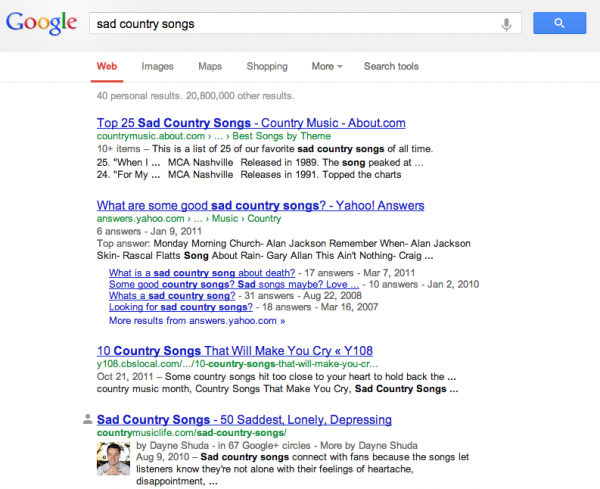SEO is a big buzz word around online marketing.
Business owners looking for new websites want to know that their new website is optimized for natural search. You are probably in this group and it makes sense. There are plenty of stories of businesses ranking well for certain terms and getting tons of traffic, leads and sales.
Well there are still a few myths surrounding SEO that have changed in the last few years. This article will prepare you for the SEO discussion you’ll have with your designer. You’ll be able to get better answers that help your site get traffic from natural search rankings.
Myth #1 – SEO and Social are Separate
SEO and Social Media are becoming more involved with each other. If you do a search on Google today there is a good chance you’ll see social information.
A recent example of how the two are involved with each other is Google Authorship. If you have a blog on your site you’ll want your designer to set this up. You’ll need to coordinate with your Google+ account to get it to work.
Here’s an example from my personal blog about country music:
The post I wrote only shows up in position 4, which is at the bottom of the screen, but the result stands out because of the Google Authorship.
SEO and social media are definitely involved with each other more than ever and it appears to be trending even more so in the future.
Myth #2 – Meta Keywords and Keywords Per Page
It’s over three years old, but people still ask about it. Google does not use the Meta Keywords function anymore. It does look like they brought back the tag in a different fashion for news sites.
When you sit down with your designer you can ignore discussions about Meta Keywords and really any conversation about putting tons of keywords on the pages of your website. It’s an SEO trick that worked for a short-term five or ten years ago, but the engines are much more advanced now and these tactics don’t work.
Myth #3 – It’s All About Links
Links used to be the most important ranking factor even in recent years and they are still hugely important. But Google has cut back on the ways links can be earned. You may have heard about the Panda and Penguin update from Google in recent years. Basically these two updates took out low quality links from Google’s ranking equation.
For years businesses would get links from tons of low quality places like forums and comments. That doesn’t work anymore.
Links are still important, but you need to have reason for someone to link to your site. This is a conversation you can have with your designer. You could partner on things like How-to Guides or interesting graphics. Interesting photos or galleries are also prime for getting links.
Establishing your brand in general is a good way to get links and those are the kind of links that are still great for SEO.
Myth #4 – Naming Structure?
One thing you should bring up with your designer is naming structure.
It’s important to have a solid structure for naming everything on the site including:
- Pages
- Posts
- Images
Each of these items can be searched including images. You want each to have a descriptive, but short name or title. People like clicking on short URLs, but they also like knowing what they’re clicking on.
Here are some examples:
Pages
Bad URL: http://www.yoursite.com/?page_id=5
Bad Title: http://www.yoursite.com
Good URL: http://www.yoursite.com/about
Good Title: About Your Company Name
Posts
Bad URL: http://www.yoursite.com/everything-you-need-to-know-about-website-design-in-five-simple-tips/
Bad Title: Everything You Need To Know About Website Design In Five Simple Steps With Interviews and Commentary
Good URL: http://www.yoursite.com/website-design-tips/
Good Title: Website Design Tips for Business Owners
Images
Bad URL: http://www.yoursite.com/images/IMG_5546574894
Bad Title: IMG_5546574894
Good URL: http://www.yoursite.com/images/website-design-tips/
Good Title: Website Design Tips for Business Owners
Myth #5 – Multiple Keywords Per Page
I’m a big fan of the idea that every page on a website should have a single key focus.
This concept works well when designing. You can discuss the single most important action you want on a page. That is most prominent and secondary actions are put in the background where they can be found, but aren’t calling visitors to action.
This concept also works well for SEO.
Each page should have one main focus.
Say your business is plumbing and you want a guide about running toilets. Your keyword would be something like “stop running toilet”. That is the focus. You should naturally use other longer and related keywords in the article, but don’t force in a bunch of repetitive keywords for the sake of SEO.
Conclusion
When you sit down with your website designer to discuss SEO use this article as a guide. You’ll be asking the right kind of questions. By implementing a few of the tips here you’ll be positioning your site for SEO success and you won’t be focusing on outdated SEO advice.






